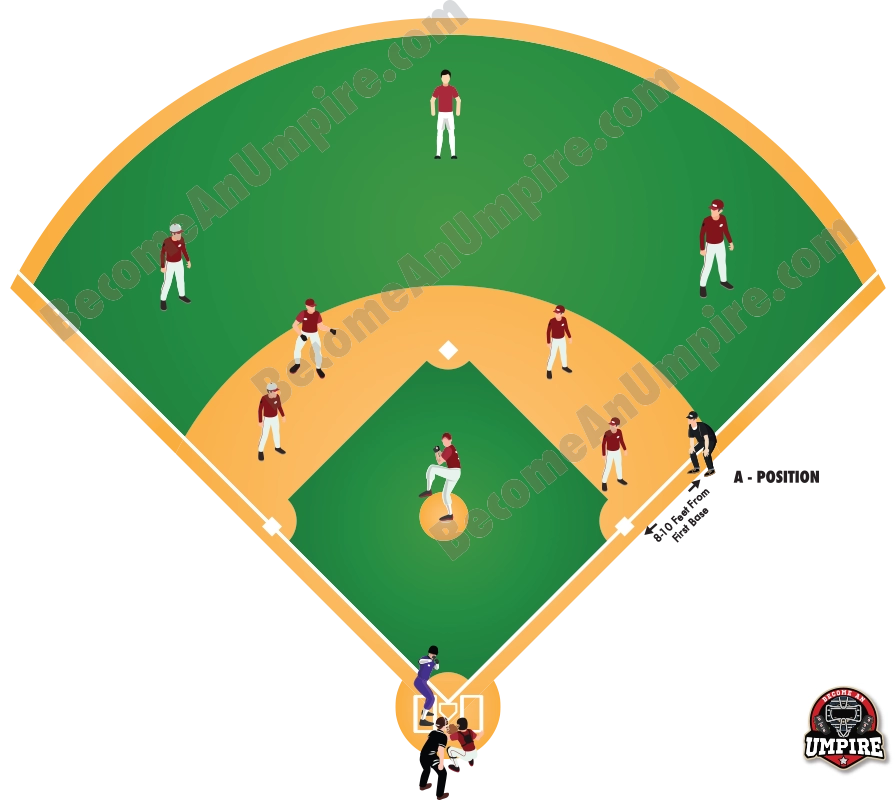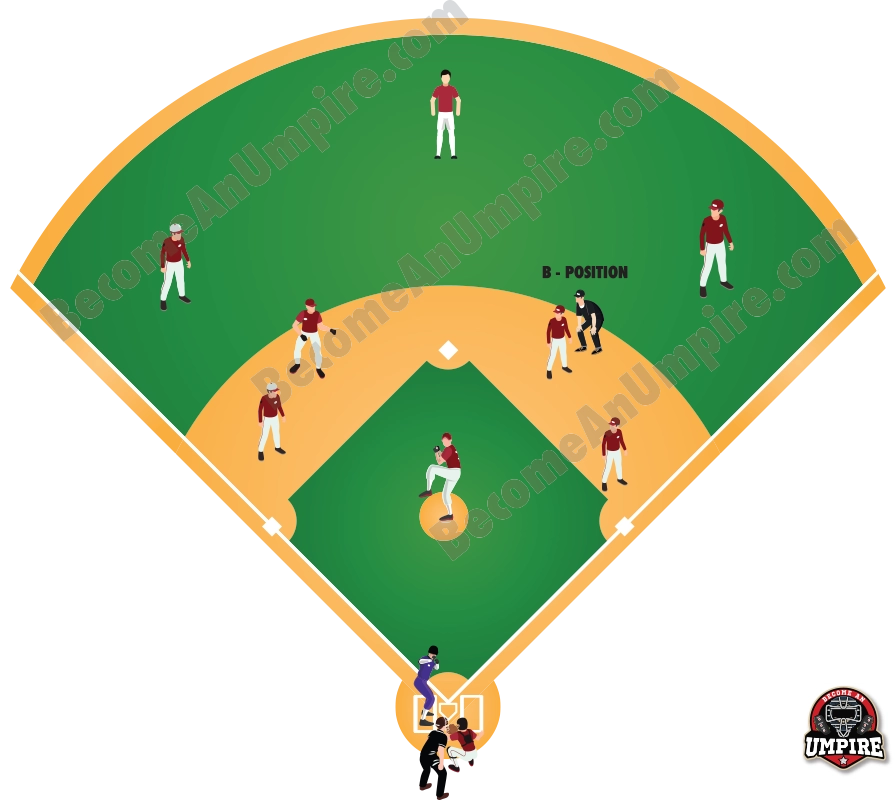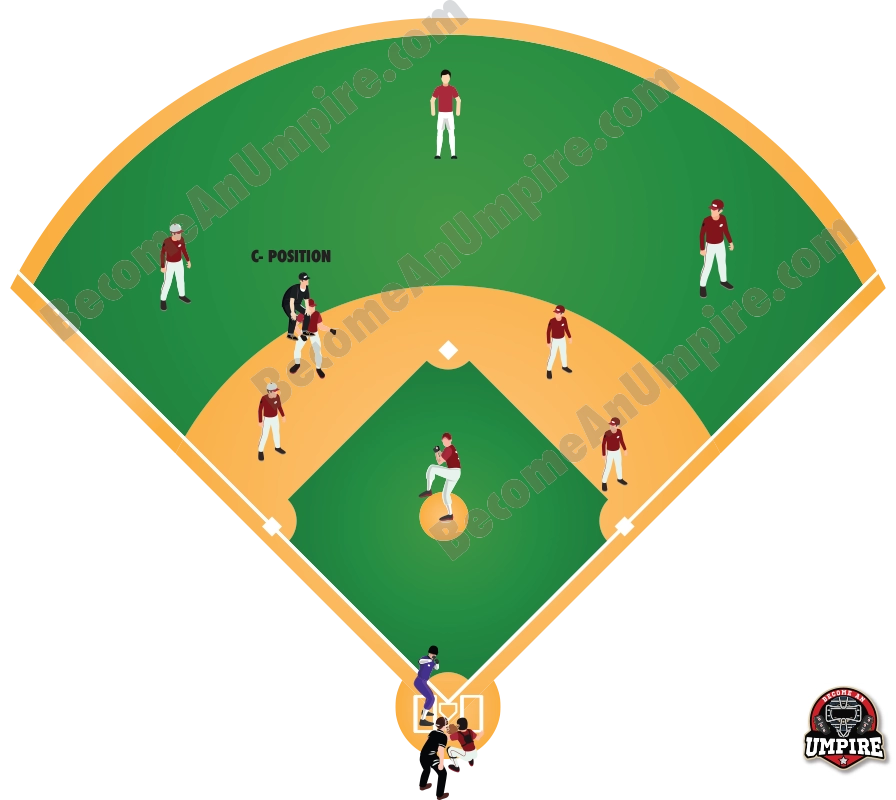A base umpire will stand in different positions during the game. The positioning depends on if there are runners on base and where the runners are. It is important to remember that Little League games are played on a 60-foot diamond, and there are no lead-offs. This is often referred to as closed bases.
When umpiring the bases, there are four different positions that you may be at during the game; they are called A, B, C & D positions. We are going to cover the two-umpire system. When there are only two umpires, the “D” position will not be used.
Let’s jump into each position, including when to stand in each position during a play. This is known as the starting position.
The Two-umpire System
No Runners On Base

With no runners on, the base umpire will be in the A Position. The A position is located behind first base in foul territory, 8-10 feet behind the first baseman. You should position your feet slightly wider than shoulder-width apart, having your right foot adjacent to the foul line but not touching it. Once the pitcher assumes a position on the pitcher’s plate, you should position yourself with a hands-on-knee set position. (A standing set is also acceptable with no runners on base.) This is the proper position if the first baseman plays at normal depth.
If the first baseman moves up in line with the base or front of it, move up slightly but never get closer than 8 feet from the bag. Getting too close to the bag gives you less time to react to the play.
If the first baseman plays deeper, you must adjust your distance behind him. You should never be even or in front of the first basemen. Always make sure you are behind him. Being behind the first baseman puts you out of the way and will keep you from being in a position to interfere if he is trying to make a play on a batted ball. Stay in the back pocket of the first baseman if they are playing deep. Remember, you have responsibilities besides just calling safe or out at first base. Refrain from positioning yourself too far back so you can’t pivot and come inside the infield ahead of the runner on a ball hit to the outfield.
In addition to plays at first base, the umpire in the “A” position is also responsible for fair/foul calls from the front of the first base bag to the right field foul pole, line drives hit directly at the first baseman or second baseman. Trouble balls are also your responsibility if the right fielder goes deep or toward the foul line (discuss this in your pre-game meeting with your partner).
Runner On First Base Only

With a runner on first base only, the base umpire will move to the “B” position. Remember, the “B” position is different on a 60-foot diamond than on a 70-foot or 90-foot. On the 60-foot diamond, the umpire will be behind the second baseman about two or three steps off their left shoulder when playing a normal position.
In this position, you want to avoid finding yourself too close to second base or too close to first base. You must adjust if the second baseman moves too close to the second base or towards the first base. You want to be approximately 25 feet to, at most, 35 feet from the first base bag. (see diagram)
Starting position for “B” is critical because you have multiple responsibilities, including the runner at first going to second and the batter-runner going to first. If you follow these guidelines, you will be in an excellent position to call both ends of a double play and see if the runner leaves the base early.
Keep your eyes on the ball and let the ball take you to the play. Remember, nothing happens without the ball.
Multiple Runners on Base

With runners on second or third base or the bases loaded, you will be in the “C” position.
The “C” position starting point is one of the toughest on the 60-foot diamond. Starting about two to three steps off the left shoulder of the shortstop will put you in an excellent position to see any plays on lead runners and give you a good view of a play at first base.
Resist the urge from starting to close to third base, You want to be no more than 30 feet from secoond base and never closer that 15 to 20 feet from third.
Responsibilities include runners on all bases. YES, I said all runners on all bases. Know your responsibilities
Runner on Third Base Only
Contrary to popular belief, as the base umpire, you will stay in the “C” position. You are responsible for the runner at third and the play at first base. Be aware there could be a snap throw from the catcher to third base.
Do not move to the “B” position with a runner on third base, regardless of how many outs there are.
